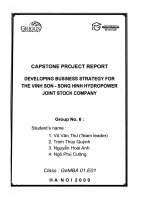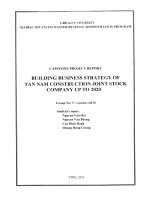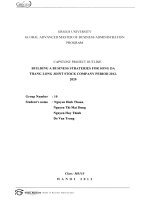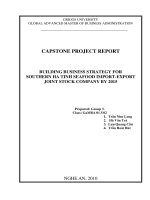Building business strategy of An Phat Plastic and Green Environment Joint Stock Company - Period 2012-2016
Bạn đang xem bản rút gọn của tài liệu. Xem và tải ngay bản đầy đủ của tài liệu tại đây (34.88 MB, 91 trang )
GRIGGS UNIVERSITY
GLOBAL ADVANCED
MASTER OF BUSINESS ADMINISTRATION PROGRAM
CAPSTONE
TITLE
“BUILDING BUSINESS STRATEGY OF AN PHAT PLASTIC AND
GREEN ENVIRONMENT JOINT STOCK COMPANY - PERIOD 20122016”
Group 2
Members:
oe
2 £
1.
Khuc Dinh Dung
Nguyen The Vinh
Bui Quang Hai
Nguyen Hoang
Nguyen Xuan Truong
Ha Noi, 2012
19" December 2011
To whom it may concern
Subject:
Comments of An Phat Plastic and Green Environment Joint Stock
Company on the project of Group 2, GAMBA01.X0710 Class - Griggs
University
NN
1. The Research Team have closely followed up the current situation of the
organization structure and the business activities of An Phat Plastic and Green
Environment JSC to implement the project;
3.
The content of "Building business strategy of An Phat Plastic and Green
Environment Joint Stock Company - period 2012-2016" project mentions
the goals that An Phat JSC is trying to reach, and has high feasibility;
The content of the project is excellent.
+
For and on behalf of
An Phat Plastic and Green Environment JSC
Kiện
Nguyen Le Trung
General Director
COMMITMENT
We, the research team, would like to commit that this Capstone project is our own
research which
is accomplished thanks to various sources of documents and real
situation. The Capstone project is not copied from any other available documents.
We undertake any legal responsibilities for the contents contained within this report.
Hanoi, December 2011
ACKNOWLEDGEMENT
The Research Team would like to express our deep gratitude to: The lecturers of
the
MBA
knowledge;
training
program
Managers
of Griggs
University
and staff of the Centre
- who
provide
for Educational
and
Technology
share
and
Career Development - Hanoi National University (ETC) - who are enthusiastic and
indispensable helpers in the process of learning;
The Research Team would also like to thank the Managers and staff of An Phat
Plastic and Green Environment Joint Stock Company - who are main supporters in
the
process
opportunity,
of studying
about
provide
support
the
the
situation
of time
of the
so that
Company
members
and
create
the
of the
group
can
complete the project.
Finally, we would like to send the most sincere thanks to families, colleagues and
classmates - who are the solid basis of spirit for members of the group during the
participation of Griggs University MBA
program and the process of completing
the Capstone Project "Building business strategy of An Phat Plastic and Green
Environment Joint Stock Company - period 2012-2016"
TABLE OF CONTENTS
a
PREAMBLE
The reason for topic selection
mm
LF
4.
Purpose and scope of the study
Implementation method
Capstone Project Report’s structure
| 1.1
1.1.1
Ẫ x..
OVERVIEW OF BUILDING BUSINESS STRATEGY
Concept of strategy
Role and significance of strategy
|Chapter! | THEORY BASIS
12
Lol
1 2.2
| ik
Ì „2s22
12.3
1.3
13,1
13.1.1
13.1.2
1.3.1.3
Lou
1.3.2.1
Lo
1.3.3
PROCESS OF BUILDING STRATEGY ˆ _
The enterprise’s vision and mission determination
External environment analysis
Macro-environment analysis
Environmental analysis of industry
Internal environment analysis
STRATEGY
SELECTION
AND
ANALYSIS
TECHNIQUE
Analysis and Information collection phase
EFE matrix
IFE matrix
Competitive profile matrix
Combination phase
SWOT matrix
SPACE matrix
Strategy Decision and selection phase
Chapter II | ANALYSIS
OF
DEVELOPMENT
STRATEGY
FORMATION BASIC
OF
AN PHAT PLASTIC
AND
GREEN
ENVIRONMENT
JOINT
STOCK
COMPANY
2.1
OVERVIEW OF AN PHAT PLASTIC AND GREEN
ENVIRONMENT JOINT STOCK COMPANY
rạn
The Company’s formation and development history
Dee
Major information of the Company
243
The Company’s organizational structure
2.1.4
The company’s human resource structure
pm ee,
Business Operating result form 2008 to 2010
21,0
Mission and vision
zu
EXTERNAL ENVIRONMENT ANALYSIS
2 +.2zÌ
Macro Environmental analysis
để „is Ð „
Political environment: (P)
Đố và la: vớ
Economic environment: (E)
£ g8 si y2
Social environment: (S)
Z số mi si
Technological environment: (T)
Page
l
l
2
2
3
3
3
3
5
6
7
7
9
10
11
lì
12
13
15
16
17
19
21
24
24
24
20
28
30
31
33
a3
i
37
39
40
42
| Judo
| 22x z]
| Dee a2
| 2a 3
| 2.2.2.4
Dida
es
2.2.3.1
| eee
Industry environment analysis_
The
The
The
The
potential competitors current competitors customer’s power
supplier’s power
44
_
44
a
sổ
46
Substitution products.
47
Opportunities and Threats evaluation of An Phat JSC
49
Opportunities and their ranking
Threats and their ranking
49
49
Competitive Profile Matrix of An Phat
51
tên... External Factor Evaluation (EFE) matrix of An Phat JSC
2.2.3.4
50
2
INTERNAL ENVIRONMENT ANALYSIS
2.3.1 __| Internal Environment analysis of An Phat JSC.
52
a2
res,
54
Dash
2.5.1.2
|Zotel
Equipment resource, infrastructure capacity.
The company’s position in industry
Technological level
52
53
54
Production Management level
Detaled
2.5.1,0
Ddelat
2idelsd
dud
25
Marketing activities
Trademarks, patent and copyright
Human Resource Management activities
Finance and Accounting activities
Summary of internal environment analysis for An Phat
Internal Factor Evaluation (IFE) matrix of An Phat
2.4.1
2.4.2
SWOT synthesis matrix
The optimum strategy selection for An Phat
2.4
FORMATION
AND
SELECTION
OPTIMUM STRATEGY FOR AN PHAT
OF
THE
60
61
62
62
63
64
65
65
68
CHAPTER | SELECTED STRATEGIES FOR AN PHAT AND
II
IMPLEMENTATION SOLUTIONS
3.1
DIFFERENTIATION STRATEGY OF PRODUCTS
71
3.2
COST LEADERSHIP STRATEGY
T5
Strategic solutions
75
Deiat
5. s2
3.13
The content of strategy
Strategic solutions
Strategic Road map
32,1
The content of strategy
Saki
Road map
2Ã.
CONCLUSION
REFERENCES
APPENDIXES
71
71
#
a
T5
76
80
81
82
LIST OF ABBREVIATIONS
In this document, the abbreviations are interpreted as follows:
[
An Phat Plastic and Green Environment Joint
ie
lun
Stock Company
EFE
External Factors Evaluation
II
Internal Factors Evaluation
QSPM
Quantitative Strategic Planning Matrix
HDPE
High-Density Polyethyiene
LDPE
Low-Density Polyethylene
rr
Polypropylene
PE
Polyethylene
PVC
Polyvinyl chloride
WTO
World Trade Organization
FDI
Foreign Direct Investment
GDP
Gross Domestic Product
LIST OF FIGURES
Page
Figure 1.1:
Michael Porter’s 5 Forces Model of Competition
10
Figure 1.2
Diagram of major activities and support activities
10
Figure 2.1]
An Phat’s organizational structure chart
28
Figure 2.2
Production of plastic of Vietnam during the period
36
2000-2010
Figure 2.3
Consumption of plastic products per capital in Vietnam
40
Figure 2.4
Main Machineries and Workshop of An Phat
3ã
Figure 2.5
SWOT synthesis matrix to An Phat
67
Figure 3.1
Implementation plan of Differentiation strategy
73
Figure 3.2
Implementation plan of Cost leadership strategy
77
LIST OF TABLES
Page
Table 1.1:
EFE Matrix
4
Table 1.2:
IFE Matrix
14
Table 1.3:
IE Matrix
14
Table 1.4:
Competitive Profile Matrix
l6
Table 1.5:
SWOT Matrix
17
Table 1.6:
SPACE Matrix
19
Table 1.7:
QSPM
a
Table 2.1:
Labour structure of the Company
3]
Table 2.2:
Business result from 2008 to 2010 of An Phat
31
Table 2.3:
Summary of the general environment analysis of An
43
Matrix
Phat
Table 2.4:
Analysis of five competitive forces to An Phat
48
Table 2.5;
EFE Matrix of An Phat
50
Table 2.6:
Competitive profile matrix of An Phat
51
Table 2.7:
List of some of the major material suppliers of An Phat
a
Table 2.8:
Cost structure of An Phat from 2008 to 2010
af
Table 2.9:
Some financial ratios of An Phat from 2008 to 2010
63
Table 2.10:
© Summary of strengths and weaknesses of An Phat
64
Table 2.11:
Internal Factor Evaluation (IF E) matrix of An Phat
65
Table 2.12:
QSPM
69
matrix of An Phat
LIST OF APPENDIXES
Page
Appendix 1:
Quality Management Certificate of An Phat
82
PREAMBLE
1. The reason for topic selection:
Vietnam's economy
world,
the
is gradually integrating into the economy in the region and the
business
environment
of the enterprise
has
been
extended,
but the
competition is becoming harder. This both has created business opportunities and
contains potential risks threatening the development of enterprises.
In order to take advantage of the oppotunities and get rid of the threats, based on the
strengths, each company must have a clear business strategy in each period of time
so as to keep the company ever-growing.
An
Phat
Plastic
and
Green
Environment
Joint-Stock
Company
is the
leading
company
in Vietnam in the plastic bag manufacturing industry. Plastic industry of
Vietnam
is
now
having
many
development, evergrowing demand
oppotunities
(incentives
for
plastic
industry
for plastic products,...) as well as facing with
many threats (tax for environment protection, high interest rate,...). How do An Phat
have to build the business strategy to have competitive advantages over competitors
and thus to develop its businesses? This is the reason why our group select the title
“Building the business strategy of An Phat Plastic and Green Environment Joint
Stock Company - period 2012-2016” to study in our capstone project.
2. Purpose and scope of the study:
The
Purpose:
and the way
Researching
to select the
strategy
optimal
building
strategy
basis,
in order
to identify their best suitable business strategy. From
solutions
toimprove
Company
incurrent
the
business
strategy
conditions. At the same
strategy
building
to help An Phat
there, making
Company
proposal
and
for An
Phat
development
process
time,
the selected
giving
process
strategic
roadmap from 2012 to 2016.
Scope of the study: Going into detail of business strategy building process of An
Phat Company for the period 2012 -2016
3. Implementation method:
Specific research methods:
analysis, comparison
and synthesis of data based on
primary and secondary data
Data collection method: Based on the information obtained through meetings with
Boads of Director of An Phat, based on information and data from An Phat that has
been published in the mass media.
4. Capstone Project Report’s structure:
The report includes the Introduction
and 03 Chapter. The main content of each
chapter is presented as follows:
CHAPTER
I: THEORY
BASIS
- Overview of Building Business strategy.
- Process of Building strategy
- Strategy Selection and Analysis Technique.
CHAPTER
BASIC
OF
II:
AN
ANALYSIS
PHAT
STOCK COMPANY
OF
PLASTIC
BUSINESS
AND
STRATEGY
GREEN
FORMATION
ENVIRONMENT
- PERIOD 2012 - 2016
- External Environment Analysis
- Internal Environment Analysis
~ Formation and selecting the optimum strategy for An Phat.
CHAPTER
III: SELECTED
IMPLEMENTATION
STRATEGIES
SOLUTIONS
- Differentiation strategy of Products.
- Cost Leadership strategy
CONCLUSION.
FOR AN PHAT AND
JOINT
CHAPTER
THEORY
1.1. OVERVIEW
OF BUILDING
I
BASIS
BUSINESS STRATEGY:
1.1.1. Concepts of strategy:
Concepts of strategy:
1.
Strategy
defining
long-term
objectives
and
purpose
of a business
and
implementing a series of actions as well as allocating necessary resources to
achieve that goal. (Alfred Chander)
2.
Strategy
is the
formula
or
plan
combining
the
primary
objectives
of
enterprise, policies and sequence in a unified manner. (James B. Quinn)
3.
Strategy is a unified, comprehensive and integrated plan designed to assure
that the basic objectives of the enterprise are achieved.
4.
Strategy, Michael L. Porter, father of the competition theory said that:
e
Firstly,
strategy is the
creation
ofthe
positionwith
the
unique value and includes different activities
e
Secondly, strategy is the choice, trade-offs in competing.
e
Thirdly,
Strategy is creation of suitability among
all activities of the
Company
First
strategy
of all,
is the way
strategy
relates
to implement
to
objectives
of enterprises.
Secondly,
the
the actions and decisions that closely relating
together and choosing coordination methods of those actions and decisions. Strategy
of an enterprise must exploit the fundamental strengths (resources and capabilities)
and must consider to the opportunities and threats of the external environments.
1.1.2. The role and importance of strategy
The strategy make contribution in better acumen and dynamic of economic
organization
towards
forecast and volatility of the market, then making
suitable
decisions
and
enterprise
and
control
their
of the
operations,
business
and
increasing
gradually
the
competitive
ensure
the
strong
strength
of
position
of
enterprises in the market mechanism.
Strategy can be considered as an
"operation platform”
of an enterprise,
is the
destination of all members to strive towards:
That's how to use the optimal combination of material resources and non-material to
achieve the given strategic objectives.
Strategy is an expression of business value conception
All enterprises have differentiation and have an individual mark in their strategic
activities. That style is an expression of the value concept, progressive spirit and the
role of the leader, who led to gain the proposed strategy objectives.
Strategy helps the leader of the enterprises to get the direction and vision in the
future:
Strategy is the basis for enterprise manager to give accurate and in time decisions
even that is the turning-point for their own enterprise, is the tool to manipulate and
identify
strengths
to
promote,
overcome
weaknesses,
take
advantage
of
opportunities, and confront challenges risks to gradually raise the position of the
enterprise.
Strategy is the creation of enterprise management:
Management is a process and strategy is a stage. Based on proposed objectives of
enterprise
and
based
on
the
problem-solving
methods
that
are
combined
in
harmony, flexibility consistent with the fact of the enterprise to create competitive
advantage for the enterprise, towards the ultimate goal is to optimize the expected
value.
Straiegy is an expression of the competitive position of enterprise: from which the
enterprise has had a way
oppertunities to overcome
competitiveness
to combine
weaknesses,
the internal strength
avoiding
factors with external
the potential
risks. That
of enterprises, the ability to capture and maintain
is the
market share
against
competitors,
the
abilities
to
create
substantial
pressure
toward
the
competitors
Michael
Porter
identified
in
his
book
“Competitive
Strategy”
that
“Competitive Strategy is in the relationship between the Company and its markets”
With
such
importance,
the enterprise
need to build for itself a long-term
business strategy, it is essential to be able to help enterprise to survive and develope
in the future. However,
the business environment are highly variable and human
resources of the enterprise also changes in each stage, thus strategy of an enterprise
should be flexible, changing to suit with the objective reality to ensure the survival
and development.
Enterprises can choose strategy according to the principle of approaching database
analysis methods based on factors such as the following sequences:
1/ Resources of the enterprise
2/ Diversification of products
3/ Product’s life cycle.
4/ Strategy of the competitors
5/ Market Demand
1.2. PROCESS OF BUILDING STRATEGY:
Established
strategy
bases
on
the
Company's
mission,
is
a
basis
for
determining the objectives and what to do for customers as well as other relevant
partners.
Based
on
this
mission,
the
leaders
will
identify
the
objectives.
These
objectives indicate clearly the organization’s mission and are used to set up action
plans and evaluation processes. These objectives are guided by practical knowledge
of
both
marketing
environment/outside
business
and
the
inside
capacity
of
enterprise. Usually, strategic making is began by extensive research and analysis ,
and
implement
a process
that thence,
leaders
identify
organizations need to solve to gain success in the long term.
the
priority
issues
that
The participation in the strategic planning process of departments plays an
important role because they have extensive knowledge about the capabilities as well
as
their
competitive
organizations
planning
environment,
should
process
do.
are more
Moreover,
can
make
clear
for those
likely to support
recommendations
departments
and
implement
are
on
applied
what
in the
the proposed
plan.
Departments are the central of strategy implementation; they have the right to lead
with necessary human resources and skills for effective implementation.
With the method of jointly implementation of planning process, the leaders
and the heads of departments ensure to build a suitable, close strategy with high
success
although
that
strategy
belongs
to
the
organization
or
the
individual
department.
Strategic implementation relates to the process right work implementation of
the organization. Both executives and managers at all levels must concentrate on the
strategy implementation, because even a perfect strategy becomes meaningless if it
is not implemented properly.
1.2.1. The Enterprise’s vision and mission determination:
Vision,
mission
indicates
the destination
of the future,
oriented
long-term
goal of enterprise, as a basis for policy development, business strategy for the short
term.
Defining
the vision
is to identify desired
position of the enterprise.
The
statement of outlines vision in the future of the enterprise is to achieve their goals
and
purposes.
The
vision
statement
must
identify
the
final
destination
of the
enterprise.
To succeed, Davidson has identified six essential factors which a vision must
have:
* Provide direction for future
* Focus on benefit of consumer
=6§=
* Reality
* Create promotion
* Being fully conveyed
* Being supervised and evaluated
A mission statement defines values and the rules that govern enterprise and
is an essential part in the process of strategic planning. The company's mission is
reason for existence of the company on the market; and which products and service
will the company
bring to their customers and community.
The decisions in the
process of strategic planning are always in harmony with the mission statement.
Mission statement is the foundation for the company's vision. The mission
statement or may
be motivation
for employees
to communicate the purpose and
value of the company to customers and communities.
1.2.2. External environment analysis:
1.2.2.1 Macro-environment analysis:
PEST model focused on researching the external environment elements that
affect on the enterprise. These elements are:
+ Political (P)
+ Economics (E)
+ Social culture (S)
+ Technological (T)
These four factors have a direct impact to the economic sector, these factors
are external
factors of the enterprise
and
industry,
and
suffer their effects as an
objective fator. The enterprises base on the impact to give the suitable policies,
business activities.
* Political:
This factor has influence to all business sectors on a
territory, institutional
and ‘aw factors and can endanger the viability and development of any industry.
Vhen trading on an administrative unit, the enterprises will be required to comply
vith the legal institutional factors in that region.
+ Stability: The institution which has high stability will be able to create
ux ... will affect sales, profits of enterprises
+ The relevant laws: the Investment Law, business law, labor law, antitrust
law, anti-dumping law e.t.c.
+ Policy: The policies of the State will have an impact on businesses; it can
nake
a
profit
or
challenges
cevelopment policy, economic
for
enterprises
development,
such
as
trade
and competition
policy,
industry
regulating policies
ad consumer protection...
* Economic factors:
Enterprises should pay attention to economic
factors both in the short term, long
t:rm and government intervention to the economy.
Usually, the enterprises will base on economic factors to decide to invest in various
s:Ctors and regions
+ The state of the economy: Any economy also has cycle, in a certain stage of
e:onomic cycle; the enterprise will have their appropriate decisions.
+ Factors affecting the economy: interest rates, inflation,
+
e:onomic
The
economic
development
policies
strategy
of the government:
of the government,
the
the
basic
salary
incentives
law,
the
policies
for
industries such as tax reduction, subsidies...
+ Economic prospects in the future: Growth speed, GDP growth rate, the rate
o GDP on investment capital...
* Social cultural factors:
Each country or territory has its cultural values and typical social factors;
these factors are characteristics of consumers
in the area.
The
social
characteristics
also make
enterprises
the social factors will divide the community
interested
when
research
market,
into customer groups, each group has
the different characteristics, psychological and income...:
+ The average life expectancy, health status, nutrition regime, food
+ The average income, income distribution
+ Lifestyle, education, aesthetic attitudes, life psychology
+ Living condition
* Technology:
The world is still in the technological revolution; a series of new technology has
been invented and integrated into the products and services especially in the field of
information technology, modern communications technology
+
Investment
by
the
government
and
enterprises
in the
R
&
D:
The
combination between enterprises and government to create new technologies, new
materials ... will have a positive effect on the economy.
The speed, technology cycle, the rate of technological backwardness:
+ The impact of information technology
and Internet on operation of the
enterprises.
* Integration factors:
No one can deny that globalization is the trend, which creates opportunities and
challenges for enterprises, countries in developing production and business.
1.2.2.2. Analysis of Industry Environment:
Analysis
developed
with
of
Industry
Environment
five affect to enterprises
Competition:
v The supplier’s power
v The customer’s power
v The potential competitors.
Y Substitution products risks
v The current competitors
according
to
or it is known
Michael
Porter
as 5 Forces
model
Model
of
Figure 1.1: Michael Porter’s 5 Forces Model of Competition
Potential competitors
Threat of New
Entrants
y
Industry Competitor
Suppli
er
>
Buyer
j
Distributor
Rivalry among existing firms
Bargainin
g Power
|
Bargainin
g Power
Threat of Substitute
Products or Services
Substitutes
1.2.3. Internal Environment analysis:
Internal situation of the enterprise is often judged
such
as
Finance,
Human
Resources;
Executive
by the functional
Management;
Organization
Structure; Marketing; Research / development, Information Technology.
Figure 1.2:Diagram of major activities and support activities
(
Fim infrestrachre
xi8
Human Resource Management
4
BG
Technolgy
2
[
Procure
Inbound =o,
iss
Outbound
RNS lục
ME
+.
ấm SN Vể
AES
(Source: Strategic management textbook - Griggs University)
- 10-
areas
The analysis of the internal enterprise will allow identifying the strengths (S)
and weaknesses
(W) of the enterprise. Since then, the chosen strategy needs to be
maximized the strengths and overcome weaknesses of the enterprise.
Similarly
in technical analysis of external factors, in order to quantify the
internal analysis of the enterprise, it is used "Internal Factor Evaluation" (IFE).
1.3. STRATEGY
SELECTION
AND ANALYSIS TECHNIQUE
There are three stages to take form Business Strategy and each stage uses different
tools
Phase 1: Analysis and Information collection phase
This phase summarizes the collected and systematized basic information to take
forms
more
Business
Strategy.
This
phase
uses
three
tools:
EFE
Matrix,
Competitive Profile Matrix and IFE matrix
Phase 2: Combination phase
This phase
is selection, arrangement
and combination
of external
environmental
factors, internal factors to make the feasible strategy. This phase will use the matrix
tools: Strengths - Weaknesses, Opportunities - Threats matrix (SWOT);
Strategic Position
Action
Evaluation Matrix
(SPACE)
and
the
Grand
Strategy
Matrix.
Phase 3: Strategy Decision and selection phase
This
stage
uses
Planning Matrix (QSPM).
a
single
QSPM
tool
that
is
the
Quantitative
Strategic
matrix using information in stage 1, objectively
evaluating the business strategies that can be selected in stage 2 to determine which
strategy is the best for enterprise.
1.3.1 Analysis and Information collection phase
Summary of incorporated basic information is necessary for the formation of
strategy. Such tools EFE matrix, Competitive Profile Matrix and IFE matrix require
strategists
to identify
strategy formation.
the objective
features
during
the previous
period
of the
The small decisions of the incorporated matrix type relate to
«hi=









